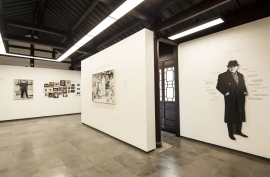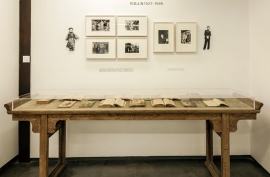Mu Xin(1927-2011) was an artist, a writer, and a poet. Born Sun Pu, courtesy named Yu Shan, is also called Sun Yang Zhong. Later, he adopted “Mu Xin”as his pen name.
Sun Pu was born on Zha Lan Bridge, Dong Zha, Wu Zhen, Zhe Jiang. At the age of five, his family moved to the “Sun Garden”located at 186 Cai Shen Bay, Dong Zha, which would later become the location for the Mu Xin Memorial. Having spent his entire childhood here, Sun Pu attended the local private school and elementary school. During war with Japan, Sun and his family once fled and took shelter in Jiang Xing. In the year 1943, Sun Pu, then 16, left Wu Zhen for Hang Zhou. Two years later he set out for Shang Hai to study art.
In 1950, Mu Xin’s mother was forced to hand over her estate, and she moved to Shanghai to live with her son. Sun’s estate was made into a factory by the Wu Zhen craft agency in march 1958, three years later it was changed into the Dong Zha iron forgery. According to the town’s people, the structure itself was still intact at the time, while ten melting pots were built in the backyard. In the year 1977, the Dong Zha iron forgery became affiliated to the Wu Zhen metal factory, which went bankrupt in the year 1995, and left the Sun’s Estate empty.
In the very same year, Mu Xin returned from New York after fifty-five years of drifting in the world. It was his first time home after he left as a young man, yet the desolation of his childhood home struck and prompted him to publish the essay “Wu Zhen”along with a poem of the same name on the “Chinese Times”of Taiwan.
1999, Wu Zhen was reborn as the conservation and development of the ancient town were underway. Chen Xianghong, then in charge of the town as well as the project to preserve and promote Wu Zhen, having read this essay and learned about Mu Xin and his achievements, was determined to welcome the old man home. He soon purchased the land on which the Sun’s estate once stood, and then carried on with the restoration process. In the year 2000, Chen finally got in contact with Mu Xin with the help of a few middle agents. The aged sojourner was moved by the sincerity and enthusiasm of his fellow town’s men, and decided to return to Wu Zhen to his former estate, now by the name of “Sunset Mansion”.
The construction of the “Sunset Mansion” started in 2001, and it the process took five years. In September 2006, Mu Xin returned to his hometown at the age of 79, until he passed away in the winter of 2011 at the age of 84.
Mu Xin was just a child when he became obsessed with art. As a young adult, he suffered from the inevitable political persecution which saw his works confiscated and he himself incarcerated. Mu Xin set out for the U.S. in 1982, afterwards he published over a dozen works in Taiwan, which sold out immediately and caused a sensation in and ouside Taiwan. In the 90s, some of his works were translated and included in literature courses of American colleges. At the start of the new millennium, Mu Xin’s art works and prison notes were exhibited at the galleries of Yale University, Chicago University, and the Hawaii University; alongside the New York Asian Academic Society. In the year 2006, Series of Mu Xin’s works were released in Chinese mainland, which earned him a large number of readers from all sorts of backgrounds. By the end of 2011, hundreds of young people from all over the country made the trip to Wu Zhen to attend Mu Xin’s funeral.
Mu Xin left home as a young man with ambitions, moved abroad as an artist seeking freedom, and returned as an wise man looking to settle down. His legendary life is an epic saga that began and ended at 186 Cai Shen Bay, Dong Zha. Wu Zhan travelling agency hired the prodigies of I.M.Pei to design and build the Mu Xin Art Gallery, which took four years to build and opened in November, 2015. In May the year before, the Sunset Mansion was set up to become the Mu Xin Memorial.
The Memorial includes three exhibits on Mu Xin’s life, art, and literature, displaying his photographs, art works, notes, belongings, and descriptions that were excerpts from his essays and poems. Due to limited space, only one tenth of Mu Xin’s six hundred art works and countless written works are on display. The memorial will display replicas of Mu Xin’s works due to the humid environment, all originals are stored in the Mu Xin Art Museum, where they are either displayed or archived.







